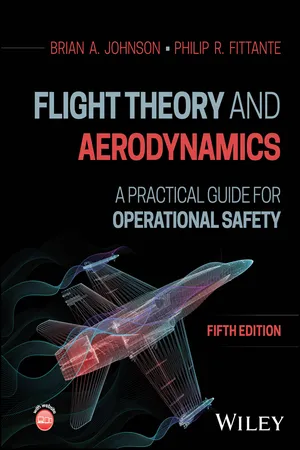
Flight Theory and Aerodynamics
A Practical Guide for Operational Safety
- 611 pages
- English
- PDF
- Available on iOS & Android
Flight Theory and Aerodynamics
A Practical Guide for Operational Safety
About this book
Comprehensive introduction to aerodynamics applied to different types of modern aircraft, now updated with the latest FAA guidance
Flight Theory and Aerodynamics provides an introduction to aerodynamics using practical application to modern aircraft with step-by-step calculations. This fifth edition streamlines content, notably the chapters on aircraft stability, and incorporates updated FAA guidance and figures from the 2023 Pilot's Handbook of Aeronautical Knowledge as well as other FAA handbooks.
A balanced application of introductory physics and meteorology in the first five chapters evolves into an introduction to propeller and jet aircraft propulsion and eventually moves into a broad discussion on the application of physics to aircraft takeoff and landing performance. After the introductory material has been presented, principles from earlier in the textbook and prior coursework are correlated and applied to slow flight, aircraft stability, and high-speed flight. A new chapter on Unmanned Aerial Vehicle (UAV) flight theory is included.
The text features extensive instructor resources including detailed PowerPoint slides for each chapter, step-by-step guidance for end of chapter calculations, sample test bank questions for each chapter, and application sections within each chapter that allow the instructor to challenge the student with additional real-world scenarios based on chapter content.
Flight Theory and Aerodynamics includes information on:
- Elements of the flight environment, covering forces, mass, scalar and vector quantities, linear and rotational motion, friction, and power
- Atmosphere, altitude, and airspeed measurement, covering properties of the atmosphere, Bernoulli's equation, and pitot-static system advantages and disadvantages
- Jet aircraft performance, covering principles of propulsion, fuel flow, specific fuel consumption, and thrust-required curves
- Aircraft stability and control, covering oscillatory motion, weight and balance, and airplane reference axes
- Rotary-wing flight theory, airfoil selection, and helicopter control
- UAV flight theory, including UAV design considerations, the aerodynamics of UAV fuselage design, UAV powerplant design, and the future of UAV design and aerodynamics
- End of chapter questions focused on scenario-based learning as applied to the performance analysis of a Diamond DA50 and corresponding chapter material.
In addition to degree-oriented college programs, this latest edition of Flight Theory and Aerodynamics is also an essential resource for pilot training programs ranging from student pilots to flight instructors as well as practicing professionals flying a wide range of aircraft.
Frequently asked questions
- Essential is ideal for learners and professionals who enjoy exploring a wide range of subjects. Access the Essential Library with 800,000+ trusted titles and best-sellers across business, personal growth, and the humanities. Includes unlimited reading time and Standard Read Aloud voice.
- Complete: Perfect for advanced learners and researchers needing full, unrestricted access. Unlock 1.4M+ books across hundreds of subjects, including academic and specialized titles. The Complete Plan also includes advanced features like Premium Read Aloud and Research Assistant.
Please note we cannot support devices running on iOS 13 and Android 7 or earlier. Learn more about using the app.
Information
Table of contents
- Cover
- Title Page
- Copyright
- Contents
- About the Authors
- Preface
- About the Companion Website
- Chapter 1 Introduction to the Flight Environment
- Chapter 2 Atmosphere, Altitude, and Airspeed Measurement
- Chapter 3 Structures, Airfoils, and Aerodynamic Forces
- Chapter 4 Lift
- Chapter 5 Drag
- Chapter 6 Jet Aircraft Performance
- Chapter 7 Propeller Aircraft Performance
- Chapter 8 Takeoff Performance
- Chapter 9 Landing Performance
- Chapter 10 Slow‐Speed Flight
- Chapter 11 Maneuvering Performance
- Chapter 12 Longitudinal Stability and Control
- Chapter 13 Directional and Lateral Stability
- Chapter 14 High‐Speed Flight
- Chapter 15 Rotary‐Wing Flight Theory
- Chapter 16 Unmanned Aerial Vehicle Flight Theory
- Answers to Problems
- Bibliography
- INDEX
- EULA